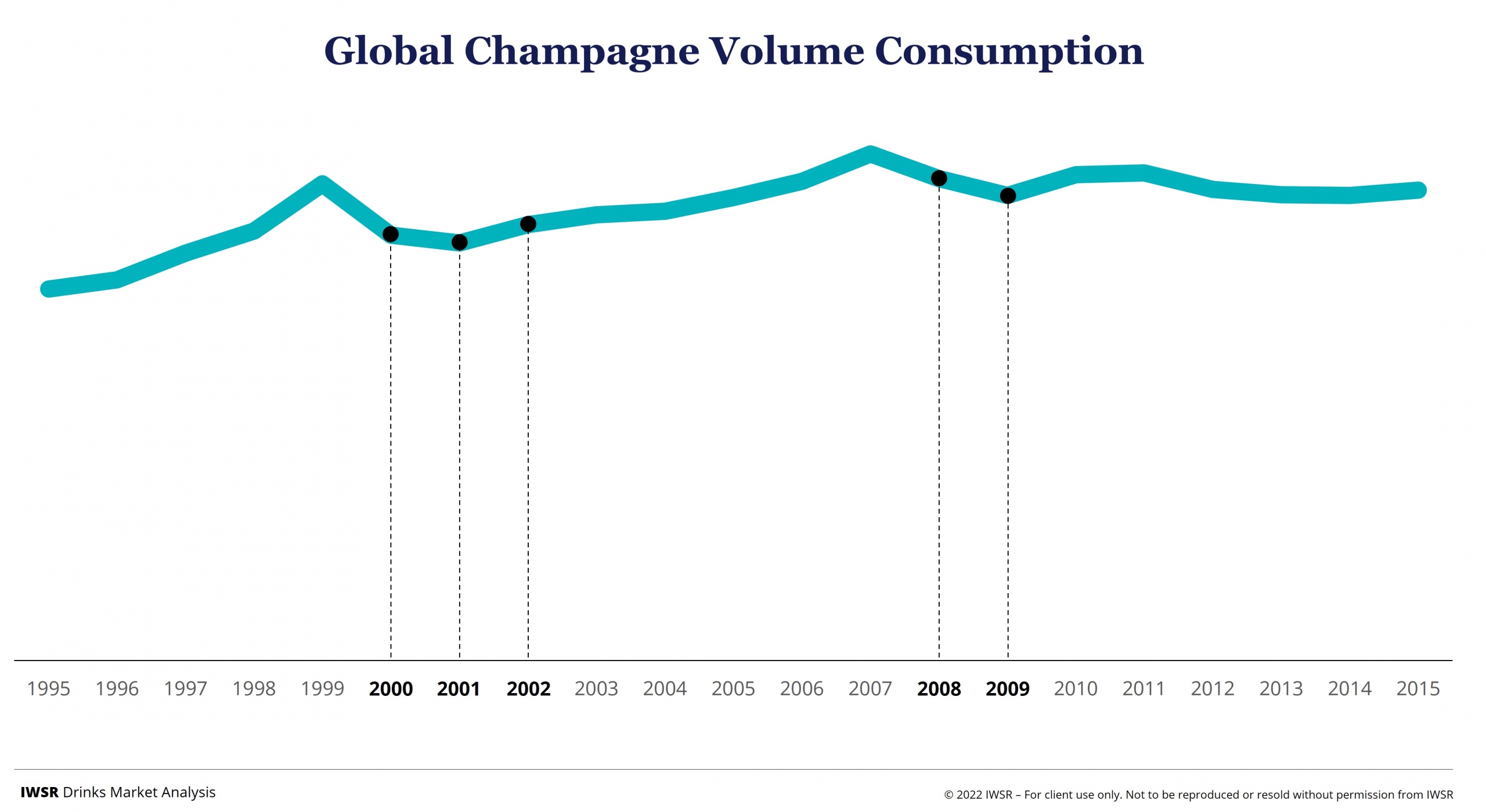Traditionally, tough economic times have meant tough times for the sparkling wine category. The recessions of the early 2000s and 2008-09 coincided with declines in volume and value of sparkling wine, particularly for Champagne.
During the pandemic, Champagne and other sparkling wines endured a rollercoaster in terms of their fortunes, with the entire category seeing a big decline in the first half of 2020, as bars and restaurants shut around the world and the notion of celebration was far from most consumers’ minds. Yet the second half of 2020 saw the category roar back to life, causing supply chain headaches around Christmas 2020. Momentum continued through 2021, with IWSR data showing that global Champagne consumption grew by over 20% in 2021, recovering to just above 2019 levels.
Whilst sparkling wine and still wine retain a very similar appeal – the audience cross-over from still to sparkling is around 80-90% in most major markets, according to Wine Intelligence data – recent trends in consumer profile and usage are showing increasing distance between the two.
Wine Intelligence profiling data for 2021 shows that, for the first time, the proportion of sparkling wine drinkers in the US who were under 40 years old (and over the legal drinking age of 21) reached 50% of the total sparkling wine drinking population – 25 million out of 50 million drinkers. Contrast this with the still wine drinking population in the US, where Millennial and legal-drinking-age Gen-Z participation in the category, as measured by monthly still wine drinkers, has fallen to less than 30% of still wine drinkers.
This younger LDA age group are also more likely to be high frequency sparkling wine drinkers, defined by Wine Intelligence as those drinking sparkling wine at least once a week.
In some ways this divergence between the age profiles of still and sparkling wine should not come as a surprise. While still wine remains dominant in the evening meal occasion, sparkling wine is enjoyed across a broader range of drinking occasions – from aperitif to brunch, pre-night out and high energy nightlife. Whilst sparkling wine is maintaining, and in some markets improving, its appeal with younger LDA drinkers, still wine is losing its appeal amongst the thirty-something drinkers of the today compared with the younger drinkers of 20 years ago.
There are some well-documented cultural reasons for this change: increasing concern about health and wellbeing has reduced midweek casual alcohol occasions, and overall alcohol intake is in decline, particularly among younger generations. By contrast, in-person social occasions have taken on a more celebratory and higher energy tone, where drinks such as sparkling wine, cocktails or flavoured ready-to-drink alcoholic beverages fit better than still wine – with the notable exception of rose wine.
Sparkling wine also has key attributes that appeal to younger drinkers – perceived universal product appeal, clear and simple category classification and distinct and appealing visual signals. While wine as a whole offers a deep well of discovery, Wine Intelligence research continues to show that consumers can find this intimidating and off-putting. By contrast, sparkling wine offers easily-grasped categories, with delineated price brackets which make choices relatively easy: is it a Prosecco occasion or a Champagne occasion? Either way, the theatrical act of opening and pouring a sparkling wine remains one of its core attributes, as a signal for a marking celebratory, treat and high energy occasions.
Additionally, sparkling wine producers continue to increase the accessibility and appeal of sparkling wine amongst LDA Gen Z and Millennial drinkers. Moves such as LVMH’s purchase last year of 50% of Jay-Z’s ‘Ace of Spades’ Armand de Brignac Champagne and the recent approval from Prosecco’s governing body to produce rose Prosecco both support the broadening the distribution and appeal of sparkling wine.
To what extent will this sparkling wine connection be disrupted by surges in the cost of living? Much will depend on what shape the coming economic crunch will take and how it will affect the Millennials, who have been the main engine of sparkling wine’s growth over the past decade.
One economic scenario that looks positive for sparkling wine is if inflation remains high for another 12 months, combined with low unemployment in the US and other developed economies, it may feed through into higher wage demands, particularly knowledge economy workers, who are disproportionately from the Millennial cohort. If these demands are met – and in the current job climate – then this group will retain much of their existing disposable income in real terms. Contrast this with older consumers, who are more likely to be on fixed incomes from pensions or investments: they are likely to see real-term declines in their incomes, and be more minded to cut down where they can.
However, another scenario is less positive – a more traditional recession. If unemployment spikes over the next few months, and upward wage pressures ease, younger adults will find themselves without as much bargaining power in the labour market, while investors (who tend to be older) will see retirement savings recover through higher interest rates and higher corporate profits. This situation would likely result in slower growth for sparkling wine, and a higher risk of downtrading in the wine category as a whole.
You may also be interested in reading:


Leave a Reply
Want to join the discussion?Feel free to contribute!